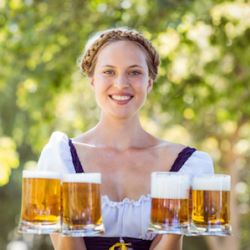For people who enjoy beer and football (be it the American or European variety), autumn is perhaps the best time of the year. The hot summer has ended, the football season is beginning, and the leaves are turning brilliant shades of amber -- not unlike the cold brewsky on tap. And for many, the climactic event of these annual rituals is the beer-swilling festival called Oktoberfest.
Beer, one of the world's favorite beverages, is chemically complex. Many different molecules are responsible for the wide variety of tastes and colors associated with beer. Of these, perhaps some of the least studied are the molecules that are produced as a result of the Maillard reaction. This reaction, famous in kitchens all over the world, is responsible for the "browning" of meats and bread that occurs at high temperatures when amino acids and sugars chemically combine. In beer, Maillard reaction products form during the brewing process.
To better understand the chemistry of beer, a team of German scientists from Technische Universität Dresden measured the Maillard reaction products (MRPs) found in different kinds of beer. Specifically, they focused on the MRPs created when sugar reacts with two specific amino acids commonly found in proteins, lysine and arginine. They chose these amino acids because, in proteins, they serve as important sites of chemical reactions. (The specific MRPs they detected, as well as a portion of their results, are shown below.)

As shown, pyrraline tended to be elevated in dark beers. However, the authors note that many other MRPs (not examined in this study) are likely the primary factors behind beer color.
Given the design of the study, the authors were almost certainly hoping to find a reliable way to chemically differentiate between beer types. Unfortunately, because there was so much variation in MRP concentration within beer samples, it was not possible to use MRPs to distinguish between them.
Alas, not all worthwhile investigations yield exciting results. At least they have a lot of beer to drink.
Source: Michael Hellwig, Sophia Witte, and Thomas Henle. "Free and Protein-Bound Maillard Reaction Products in Beer: Method Development and a Survey of Different Beer Types." J. Agric. Food Chem., Article ASAP. Published: 3-September-2016. DOI: 10.1021/acs.jafc.6b02649

